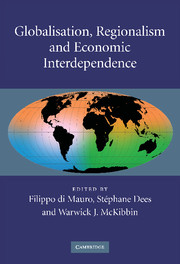Book contents
- Frontmatter
- Contents
- List of figures
- List of tables
- List of contributors
- Preface
- Introduction
- 1 International linkages in the context of global and regional integration
- 2 Trade integration of the central and eastern European countries and China: has it reached potential?
- 3 Patterns and determinants of production fragmentation in world manufacturing trade
- 4 Going global: trade, internationalisation of production and domestic performance of euro area firms
- 5 Globalisation and the trade channel in the euro area
- 6 Gauging the labour market effects of international trade openness: an application to the US manufacturing sector
- Index
- References
2 - Trade integration of the central and eastern European countries and China: has it reached potential?
Published online by Cambridge University Press: 02 September 2009
- Frontmatter
- Contents
- List of figures
- List of tables
- List of contributors
- Preface
- Introduction
- 1 International linkages in the context of global and regional integration
- 2 Trade integration of the central and eastern European countries and China: has it reached potential?
- 3 Patterns and determinants of production fragmentation in world manufacturing trade
- 4 Going global: trade, internationalisation of production and domestic performance of euro area firms
- 5 Globalisation and the trade channel in the euro area
- 6 Gauging the labour market effects of international trade openness: an application to the US manufacturing sector
- Index
- References
Summary
Introduction
The emergence of China as a global player and the awakening of the central and eastern European countries after the fall of the ‘Iron Curtain’ have been breathtaking events, both for the euro area and for the global economy at large. This is strikingly evidenced by the reorientation of global flows in goods and service and the unprecedented speed at which trade integration of both China and the CEEC with western European economies has progressed since the beginning of the transition process in the early 1990s. Not only did the brisk pace of market integration affect regional and global trade patterns, it also triggered tensions in the political and economic sphere, as it was perceived to affect adversely the competitiveness and employment situation in partner countries.
This chapter contributes to this policy debate by proposing a new benchmark measure for the trade intensity of the CEEC and China. Overall, the dynamic growth of external trade with these transition economies is hardly surprising. The former inward orientation of these countries associated with central planning, their policy-induced geographical trade specialisation (e.g. within Comecon, the Council for Mutual Economic Assistance, for the CEEC), had to adjust towards more marketbased structures as they opened up. The transformation of regional and global trading patterns was further fostered by the robust economic growth recorded in the transition countries over the past decade or so, and – in the case of the CEEC – their geographical proximity to the euro area.
- Type
- Chapter
- Information
- Globalisation, Regionalism and Economic Interdependence , pp. 22 - 44Publisher: Cambridge University PressPrint publication year: 2009



